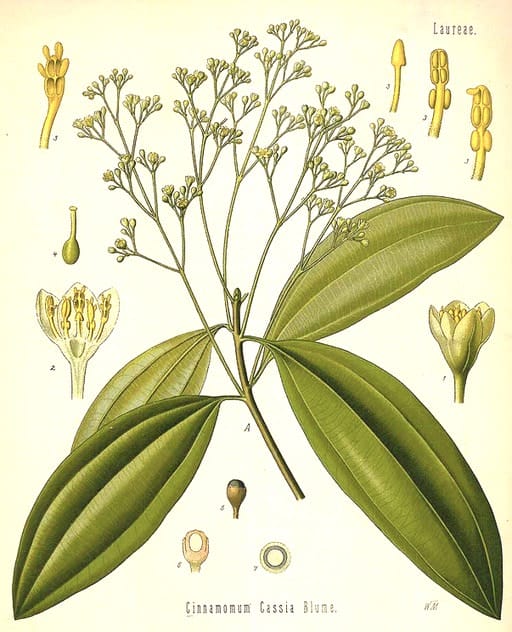Cinnamon twig, Gui Zhi 桂枝
Gui Zhi (TCM) Koehler, Medizinal Pflanzen, 1887
Koehler, Medizinal Pflanzen, 1887Botanical name:
Cinnamomum cassia
Parts used:
twigs
Temperature & Taste:
Warm, dry. Pungent, Sweet
Classification:
A. Clear Exterior Wind-Cold
Uses:
1. Clear Wind-Cold, Promotes Sweat:
-acute Wind-Cold with sweat; Cold, Flu
-“It relieves headache due to invading pathogenic Wind … expels exterior syndrome and induces perspiration” (Zhang Yuan Su)
2. Warms the Yang, Clears Cold:
-Palpitations from Heart Cold and Obstruction
-Edema associated with Cold
-also Amenorrhea associated with Cold obstruction
-“tonifies the interior and reinforces Qi”. (Shen Nong Ben Cao Jing)
-“It treats Heart pain” (Ming Yi Bie Lu)
3. Clears Wind-Cold-Damp, Opens the Channels, Clears Obstructions:
-Arthritic and Rheumatic complaints, especially of the Upper body
-muscles and joint stiffness and pain from Wind-Cold-Damp
-“facilitates movement of the joints” (Shen Nong Ben Cao Jing)
Dose:
1. Take with Wine, Decocted in Wine, or the Tincture is better to Move the Blood.
2. Taken as a hot decoction to promote Sweat.
Decoction: 3–9 grams; 9–15 grams for painful obstruction; maximum 3–6 grams during Pregnancy.
Powder: 1–3 grams
Comment:
1. Cinnamon twig (Gui Zhi) is regarded as thin and light whereas Cinnamon (or Cassia) bark is thick and heavier. Cinnamon twig therefore moves up and clears (Wind-Cold-Damp from) the Exterior, while Cinnamon (or Cassia) moves inwards and downwards, and warms and strengthens the Kidneys.
2. ‘Twig of cinnamon is similar in appearance to cinnamon, but is larger, longer, and a little woody. its properties and fragrance are weaker than cinnamon, but it is used for the same purposes, and can be substituted for cinnamon’. (Galen)
Preparations:
1. Dry-Fried Cinnamon Twigs (Chao Gui Zhi):
The twigs are dry-fried until golden. These are less pungent and dispersing, but more warming and better to clear Cold-Damp painful obstruction. This is better for acute Wind-Cold in weak individuals. It is also better when used during Pregnancy.
2. Honey-prepared Cinnamon twigs (Zhi Gui Zhi):
Fried with Honey increases its warming, Yang strengthening qualities, but reduces the exterior-dispersing, sweat-inducing effect. It is better to warm the Stomach and tonify the Yang.
3. Wine-prepared Cinnamon-twig (Jiao Gui Zhi):
Wine-fried Cinnamon twig is better to warm the Yang and move the Blood. It can be used for Palpitation and Chest pain associated with Cold and Yang deficiency.
Main Combinations:
Cinnamon twig Gui Zhi & Paeonia Bai Shao
1. Acute Wind-Cold Cold and Flu:
i. Cinnamon twig Gui Zhi with Saposhnikovia Fang Feng
ii. Cinnamon twig Gui Zhi with fresh Ginger and Paeonia Bai Shao
2. Acute Wind-Cold with Cough and Wheezing:
i. Cinnamon twig Gui Zhi with Almond (Xing Ren) and Magnolia bark (Hou Po)
ii. Cinnamon twig Gui Zhi with Ephedra Ma Huang, Almond (Xing Ren), Licorice
3. Acute Wind-Cold with spontaneous or excessive sweating, Cinnamon twig Gui Zhi with Paeonia Bai Shao.
4. Acute Wind-Cold Muscle and Joint Pain:
i. Cinnamon twig Gui Zhi with Saposhnikovia Fang Feng
ii. Cinnamon twig Gui Zhi with Stephania Han Fang Ji
5. Chronic Wind-Cold Joint Pain:
i. Cinnamon twig Gui Zhi with Myrrh (Mo Yao), Frankincense (Ru Xiang), Achyranthes Niu Xi, Eucommia Du Zhong, Saposhnikovia Fang Feng, Licorice (as in Shu Feng Ding Tong Wan)
6. Heart Yang deficiency with Palpitation and Breathlessness:
i. Cinnamon twig Gui Zhi with Licorice (Honey-fried)
ii. Cinnamon twig Gui Zhi with Licorice and Aconitum Fu Zi.
7. Heart Qi and Blood stagnation, Chest pain:
i. Cinnamon twig Gui Zhi with Saffron
ii. Cinnamon twig Gui Zhi with Asarum Xi Xin
8. Palpitations and Chest pain from Yang deficiency (Coldness) and Blood stagnation, with Salvia Dan Shen.
9. Irritability and Insomnia from associated with Heart Yang deficiency with ‘floating Yang’, Cinnamon twig Gui Zhi with Oyster shell Mu Li and Fossil Bone Long Gu.
10. Internal Dampness, Cinnamon twig Gui Zhi with Poria Fu Ling, Atractylodes Bai Zhu
11. Menstrual Pain from Cold obstruction, Cinnamon twig Gui Zhi with Dang Gui and Cyperus rotundus
12. Irregular Menstruation and Infertility from Cold and Weak Kidneys, Cinnamon twig Gui Zhi with Evodia Wu Zhu Yu, Dang Gui and Paeonia Mu Dan Pi.
13. Blood stagnation from Trauma; Dysmenorrhea or Fibroids from Blood stagnation:
i. Cinnamon twig Gui Zhi with Peach kernel (Tao Ren), Poria Fu Ling, Paeonia Mu Dan Pi. (as in Gui Zhi Fu Ling Wan)
14. Blood stagnation from Trauma, Cinnamon twig Gui Zhi with Myrrh and Frankincense
15. Spermatorrhea from exhaustion, Cinnamon twig Gui Zhi with Oyster shell Mu Li, Fossil Bone Long Gu, Atractylodes Bai Zhu, Licorice, fresh Ginger and Chinese Dates (Da Zao)
16. Edema or fluid retention from Yang deficiency, Cinnamon twig Gui Zhi with Poria Fu Ling.
Major Formulas:
Chai Hu Gui Zhi Tang
Chai Hu Gui Zhi Gan Jiang Tang
Gui Zhi Tang
Gui Zhi Fu Ling Wan
Gui Zhi Fu Zi Tang
Gui Zhi Gan Cao Tang
Gui Zhi Jia Long Gu Mu Li Tang
Gui Zhi Jia Shao Yao Tang
Gui Zhi Ren Shen Tang
Gui Zhi Shao Yao Zhi Mu Tang
Da Qing Long Tang
Dang Gui Si Ni Tang
Fu Ling Gui Zhi Gan Cao Da Zao Tang
Huang Qi Gui Zhi Wu Wu Tang
Ling Gui Zhu Gan Tang
Ma Huang Tang
Shen Qi Wan
Shu Feng Ding Tong Wan
Tao He Cheng Qi Tang
Wei Ling Tang
Wen Jing Tang
Xiao Jian Zhong Tang
Xiao Qing Long Tang
Zai Zao San
Zhi Shi Gua Lou Gui Zhi Tang
Zhi Shi Xie Bai Gui Zhi Tang
Cautions:
1. Pregnancy; use cautiously during pregnancy, 3 grams to a maximum of 6 grams daily, preferably the dry-fried twig should be used. It should not be used if there are signs of Heat during Pregnancy.
2. Excess Menstruation, dose is 3–6 grams and the dry-fried herb should be used.
3. Strong Heat / Fire conditions
4. Febrile disease
